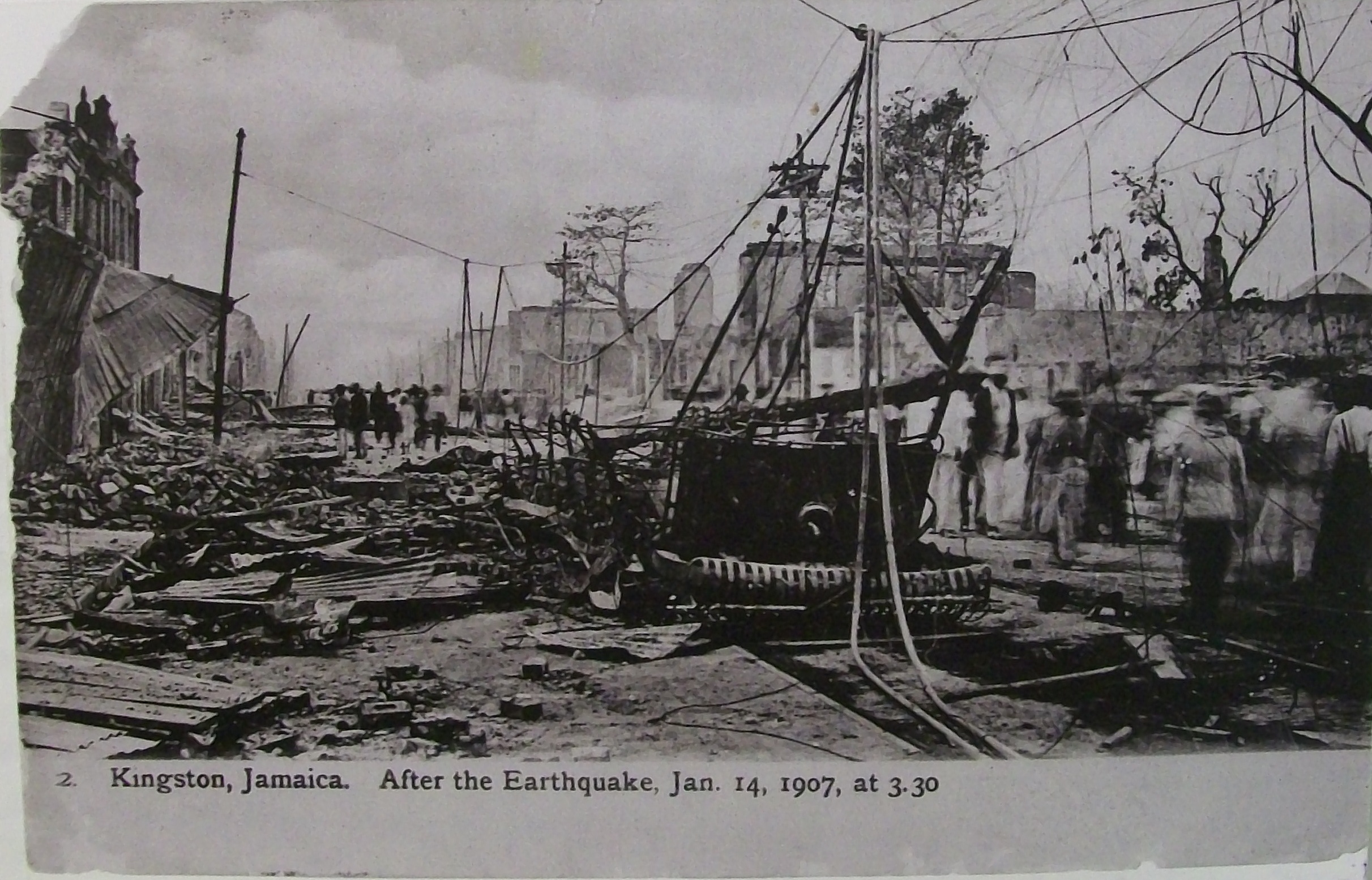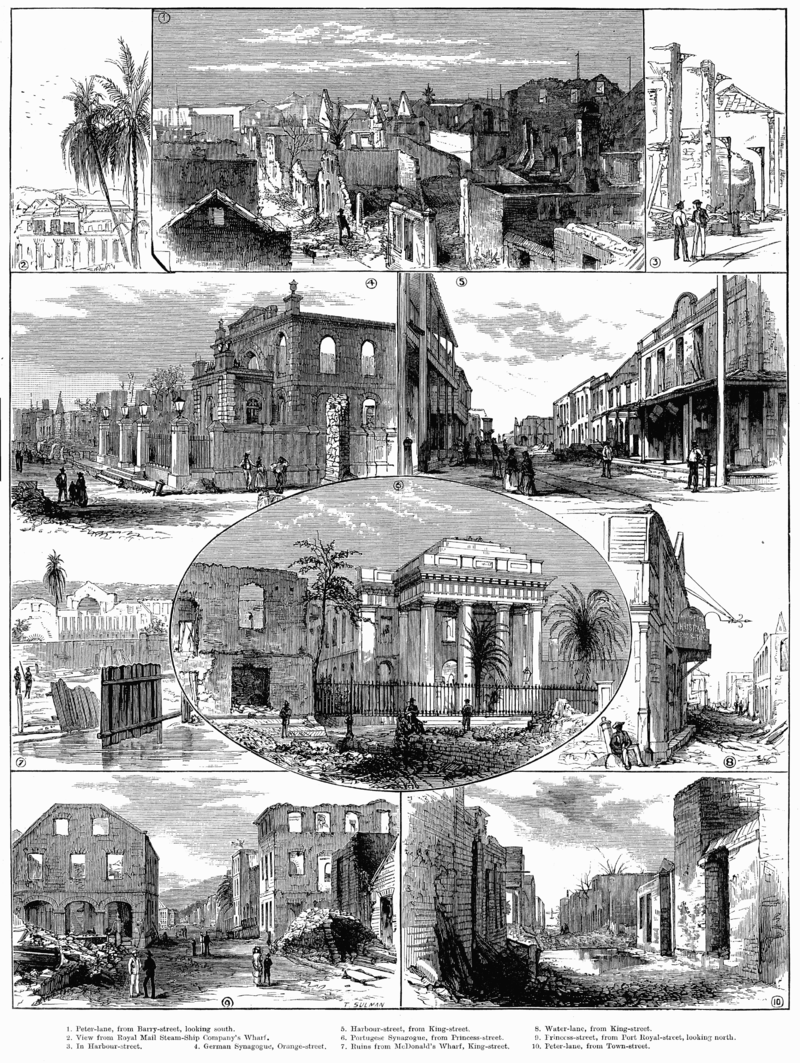
A section of Kingston after the 1907 earthquake and fire (Public domain)
This past week’s fire at Wisynco, one of the largest private companies in Jamaica, and the March 2015 Riverton fire in Kingston that raged for days, causing millions of dollars in damage, remind us that fires are a constant threat. A good number of fires affected the island, especially Kingston and Port Royal, in earlier centuries.
The most well-known fire in Jamaica’s history raged after the January 14, 1907, earthquake that devastated large parts of Kingston. J.F. Wilson, writing in 1910, reported that “ten minutes after the first [earthquake] shock, flames burst out in the ruins and raged for three hours before any efforts were made to check them.”
He said “among the distressing features of the entire disaster was the burning of the Military hospital in which 40 soldiers were burned to death before any effort could be made to save them.” It appeared aftershocks and fire happened simultaneously. “A second, third, fourth and fifth shock followed in close succession. By this time flames had broken out in six different sections of the town and began eating their way through the ruins, and many people were roasted alive. Their cries could be heard above the roar of the flames. Pandemonium reigned supreme.”
The 1907 fire and quake left an indelible mark on Jamaica’s capital for years, accounting for the death of about 800 persons. But this was not the first. The first known major fire to strike Kingston was in 1780. The town “was severely stricken by a great fire which broke out at about 2 o’clock in the morning of the 16th May and continued until the following evening,” so said early editions of the Handbook of Jamaica, first published in the late 19th century. “The large and closely built portion of the town lying between King and Orange Streets was burnt down, the destruction of property being estimated at £30,000,” or £1.9 million in today’s currency.
At least three significant fires occurred in the 19th century, roughly 20 years apart. On August 26, 1843, fire “devastated a large portion of the city…. Many of the best dwellings and much valuable property were consumed and a large number of persons were left in utter destitution.”
Another occurred in March 1862, “by which the commercial division of the city was devastated,” including “nineteen of the principal stores in Harbour and Port Royal Streets, three wharves, and the extensive and well-built three storied house in which the Commercial Hotel was kept.” Damage was £90,830 or £4 million today.

An artistic overview of Kingston after the 1882 fire (Courtesy of www.wikiwand.com)
On December 11, 1882, “a calamitous fire occurred in Kingston… by which the greater part of the business portion of the town was destroyed, much valuable property consumed and great distress occasioned to the poorer classes,” the Handbook of Jamaica recounted. An eyewitness, Pursey Coffey, alleged the fire started “in Feurtardo’s lumber-yard on Port Royal Street.”
The fire seemed to have benefited from strong wind. The New York Times on December 22 reported that “the flames seemed to spread with great rapidity. The wind was blowing from seaward at the time, and burning pieces of wood were carried up in the air and distributed in all directions to leeward.” After a lull in the wind, it “then changed into a strong land breeze” that “drove the flames down toward the water’s edge.” This was significant as a large segment of the town had gathered on the wharves to escape the flames, but the fire followed them. Hundreds were saved by ships docked in the bay.
At least 12 persons were known to have died. Some 689 houses were severely damaged or destroyed affecting some 6,000 persons. The Spanish and Portuguese Synagogue, situated on Princess Street (more about the Jews in Jamaica in a future blog post), lost everything with the “exception of one register book of Births, Marriages and Deaths.”
Estimates of the damage varied. The Handbook of Jamaica and other sources reported the damage at between £160,000 and £200,000 or £7.7 million to £9.7 million in today’s currency. The New York Times put it at £2.5 million or more than £120 million at current rates. This is a massive discrepancy. In any case, the 1882 fire was far worse than those in either 1843 or 1862. Then, within another 25 years, earthquake and another fire devastated the city.
Port Royal, that much beleaguered town, had a major fire in 1703, believed to have begun in “crowded warehouses where a quantity of gunpowder was deposited.” This fire, occurring just over 10 years since the massive 1692 earthquake that destroyed much of that town, led to mass evacuation. It appears the 1703 Port Royal fire was the catalyst, following on the earthquake there earlier, for Kingston becoming the urban center it is today, as “the disheartened inhabitants went in large numbers to Kingston.” The Jamaica Assembly provided generous terms to colonialists who relocated to Kingston, providing tax free land and residency for up to seven years and mandating that St. Andrew owners of slaves provide labor for the building project to house the evacuees.
Yet other Port Royal fires took place in 1728 and on July 13, 1816, the latter at about midday, “which in a few hours destroyed nearly the whole place, including the naval hospital; and left many of the inhabitants utterly destitute.”
With so many fires occurring in Kingston and Port Royal and elsewhere across the island, it is not surprising that insurance companies took an early foothold in Jamaica. Jamaica’s governor, John Peter Grant, was patron in the founding of the Jamaica Cooperative Fire Insurance Company in 1873. “The Company was formed with the object of reducing the rates of Fire Insurance in this island and of retaining in the island the large amount of money annually sent away as premiums,” the Handbook recorded. It appears activities in the fire insurance market was hectic indeed. By the early 20th century there were about 25 local agents for overseas insurers.
Other towns such as Savanna-la-Mar in 1779 and Montego Bay in 1795 and 1808 were devastated by fires. Several reasons accounted for why so many fires happened back then and why these fires caused so much loss and damage – overcrowding, population density, fragile structures, the presence of flammable and volatile materials in high population areas and in commercial centers, lack of emergency response personnel and equipment, poor training, etc.
The Wisynco fire last week and the costly March 2015 Riverton fires remind us of destructive fires of the past. As a Wisynco manager promised, the company will bounce back; in the same way the city of Kingston and other towns rose from the ashes many times before.
Very informative Eron. My first job after high school was with Wisynco , the same place I would go for my Summer jobs while in college. I am very disappointed to hear it’s burnt out. Given the flammable nature of the products made there I can only hope that their fire prevention strategies were up to par and truth be told my gut feeling is that it wasn’t. History relived…..sigh.
All these hotels going up on the island, how reputable are our quality controls, how prepared is our fire department to respond to a real fire on one of our high rises? I prefer my bookings on the second floor, no higher than the third. The town of Ocho Rios is becoming very dense, that area around the market place looks like a fire trap. I just hope the people with oversight responsibilities are able to see. Great article brother!
It is a matter of serious concern, Dennis. Not wanting to pass judgment before looking into it more closely, the matter of fire prevention and response is something that demands urgent action if there are defects in the system. One area to look at is the number and quality of marine fire boats. Some years ago, this was an area where Jamaica lacked adequate capability. It would be interesting to know if this has been addressed. If there is a major fire aboard a ship or boat, does Jamaica have adequate capacity and readiness to respond?